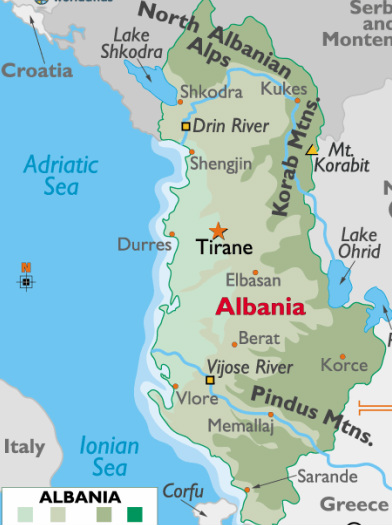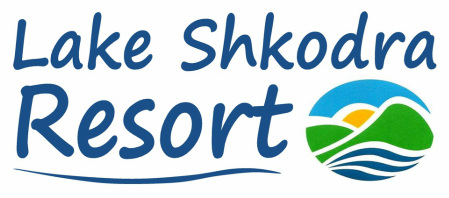Albania
|
Population – 2.8 million in 2022 Currency - Leke Languages – Albanian Foreign visitors to the country 2022 – 7.5 million Climate - A Mediterranean climate with long hot summers and rain unusual in the summer months. Airports - The closest airports to Lake Shkodra Resort are: Podgorica Airport, Montenegro (49km). Tirana Airport, Albania (93km). Click for flight details. Ports - The main ports have regular scheduled ferries to and from: Durres, Albania (118km) to Bari, Trieste, Ancona and Brindisi (Italy). Vlora, Albania (229km) to Brindisi (Italy). Saranda, Albania (357km) to Corfu (Greece). Click for ferry details. |
Transport
Taxis are widely available and can be booked through Lake Shkodra Resort to pick up from airports or other destinations.
Car hire is available at Tirana airport from car hire companies such as Hertz and Europcar.
Minibuses `like dolmuses’ can be flagged down at the side of the road. They are cheap and frequent, passing every 3-4 minutes. A journey from the public road near the resort to the center of Shkodra costs less than €1 per person and takes 10 minutes. A single trip to Tirana airport currently costs €8.
Mountain bikes & canoes can be hired from the reception.
Car hire is available at Tirana airport from car hire companies such as Hertz and Europcar.
Minibuses `like dolmuses’ can be flagged down at the side of the road. They are cheap and frequent, passing every 3-4 minutes. A journey from the public road near the resort to the center of Shkodra costs less than €1 per person and takes 10 minutes. A single trip to Tirana airport currently costs €8.
Mountain bikes & canoes can be hired from the reception.
Overview
Albania is a small thin country and has over 360km of unspoilt Adriatic and Ionian coastline, uninhabited islands, lakes, mountains, nature reserves and UNESCO world heritage sites. UNESCO world heritage sights include – Butrint, famous for its ancient Greek and Roman ruins, which include a Roman amphitheater, public baths and early Christian basilicas. Berat for its well preserved 13th century town and Gjirokastër or Gjirokastra for its Ottoman architecture.
Media & Newspaper Articles
The Guardian Newspaper
https://www.theguardian.com/travel/albania
Albania sets its sights on high-end eco tourism - 2023
Looking for an affordable beach holiday? Head to eastern Europe - 2023
Beaches, mountains, ancient towns and low prices? Albania has it all - 2022
UK tourists head to Albania for ‘sense of exotic’ without long-haul flight - 2022
Kala festival, Albania: party time in what feels like a paradise - 2018
Adventure in Albania: kayaking in one of Europe's final frontiers - 2018
Testing the water in Albania - Lake Koman - 2012
Albania sets its sights on high-end eco tourism - 2023
Looking for an affordable beach holiday? Head to eastern Europe - 2023
Beaches, mountains, ancient towns and low prices? Albania has it all - 2022
UK tourists head to Albania for ‘sense of exotic’ without long-haul flight - 2022
Kala festival, Albania: party time in what feels like a paradise - 2018
Adventure in Albania: kayaking in one of Europe's final frontiers - 2018
Testing the water in Albania - Lake Koman - 2012
The Sunday Times, Travel
https://www.thetimes.co.uk/travel/destinations/europe/albania/
Albania travel guide. When to go, what to do, and why you'll love it - 2023
Best things to do in Albania - 2022
Albania travel guide. When to go, what to do, and why you'll love it - 2023
Best things to do in Albania - 2022
The Telegraph, Travel
https://www.telegraph.co.uk/travel/destinations/europe/albania/
The secret (and cheaper) alternative to Greece and Italy - 2022
Albania: Why it's time to put this ancient country on your holiday wish-list - 2018
The secret (and cheaper) alternative to Greece and Italy - 2022
Albania: Why it's time to put this ancient country on your holiday wish-list - 2018
The New York Times
https://www.nytimes.com/interactive/2023/travel/52-places-travel-2023.html
The New York Times 52 Places to Go in 2023 - Albania No. 8
The New York Times 52 Places to Go in 2023 - Albania No. 8
Lonely Planet
New P&O cruises to boost Albanian tourism
International cruising giant P&O added the Albanian resort of Durres to its ports of call in 2012.
Albania & Montenegro: Safer than Western Europe
The Balkans, a region once known as a hotbed of crime and violence, has become one of the safest zones in Europe according to the United Nations. “The vicious circle of political instability leading to crime, and vice versa, that plagued the Balkans in the 1990s has been broken,” said Antonio Maria Costa, head of the United Nations Office on Drugs and Crime.
The bloody breakup of former Yugoslavia — the worst carnage in Europe since World War II — left the region in turmoil throughout the 1990s, but a United Nations report says the levels of crime against people and property are now lower in the Balkans than in Western Europe. The United Nations report says this trend of reduced crime is likely to continue as the region lacks the usual factors that lead to crime elsewhere in the world: mass poverty, income inequality, runaway urbanisation and large-scale youth unemployment.
The bloody breakup of former Yugoslavia — the worst carnage in Europe since World War II — left the region in turmoil throughout the 1990s, but a United Nations report says the levels of crime against people and property are now lower in the Balkans than in Western Europe. The United Nations report says this trend of reduced crime is likely to continue as the region lacks the usual factors that lead to crime elsewhere in the world: mass poverty, income inequality, runaway urbanisation and large-scale youth unemployment.
BBC News - NATO - Welcomes Albania and Croatia 01.04.09
Albania and Croatia have officially joined the NATO military alliance. The two states became NATO’s 27th and 28th members after their ambassadors to the US filed their instruments of accession at a ceremony in Washington. Correspondents say NATO wanted to mark its 60th birthday at a summit this week with a symbolic expansion into a region which only a decade ago was at war.

